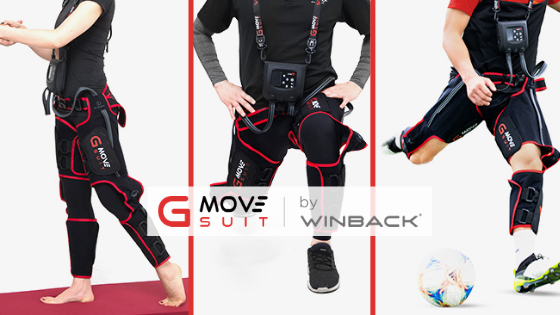Thanks to active compression, the GMOVE-SUIT offers a unique therapy. It allows compression of the lower limbs while maintaining mobility. With adjustable sleeves, a wide range of pressures and three different casing inflation programmes, the applications are varied. The primary goal of active compression is to optimise venous return which will lead to concomitant effects.
Here is a summary of potential uses
Orthopaedic / traumatological rehabilitation
GMOVE-SUIT active compression is used in orthopaedics and traumatology. During rehabilitation, the equipment is used during the entire treatment cycle. The device can also be used to reduce oedema (passive use) by optimising venous return.
GMOVE-SUIT accompanies the patient in the return to walking, which is done more quickly and with better support of the lower limbs. Pain is reduced while combating orthostatic problems. During dynamic exercises, the pressure situated around 60 to 90 mmHg will induce a better activition of the mechanoreceptors, increased endurance and promotes recovery during and after the effort.
Muscular strengthening at the end of the cycle is used thanks to the pressure around 120 mmHg, in a preventive approach. At this pressure, the tissues are intensely stimulated while protecting the patient from a relapse.
Muscle Recovery / Performance Improvement
For muscle recovery, users choose their pressure according to the type of recovery they would like to apply. For passive application, the 0G programme will be selected with a pressure around 90 mmHg.
For active application (walking, cycling or running), 0G is the best way to use the full potential of the GMOVE-SUIT for muscle recovery. The 2G programme works with dynamic exercises aimed at muscle recovery with pressure around 90mmHg.
The 4G programme at high pressure, will allow “Blood Flow Moderation” by limiting the oxygenation of the muscle. The aim is to get as many muscle fibres as possible to contribute to improving their performance.
Psychomotor disorders
Following our tests and scientific research, low pressure applied in a constant way thanks to the 4G program allows an optimisation of the mechanoreceptor activities. Post-stroke patients, patients with multiple sclerosis, Elhers-Danlos syndrome or Parkinson’s disease are potential users however, different factors need to be taken into account such as the stage of the disease, other underlying pathologies and the general health of the patient.
Conclusion
Pressure and programmes are very important depending on the application and the objective. Possibilities are very broad and allow the use in several areas. The search for optimisation of venous return through compression allows many beneficial effects. The aim is to be able to exploit them to the maximum by relying on the mobility of the lower limbs.

